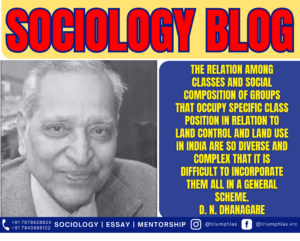Explain the implications and the impact of globalisation in situating the changing agrarian class structure in India
Section: A.
Sociology Paper 2023 Analysis.
Relevant for Paper 2: Unit-12 Social Classes in India; Agrarian Class Structure

Question 4 (b): Explain the implications and the impact of globalisation in situating the changing agrarian class structure in India
(20 Marks)
|
Introduction: Introduce Globalization’s Impact on India’s Agrarian class Structure, Mentioning its Definition and Significance Main Body: Discuss the Traditional Agrarian class Structure, Sociological Shifts due to Globalization, and the Emergence of new Classes. Address key Points such as Changes in Agricultural Practices, Market Integration, and Socioeconomic Inequality Conclusion: The need for Equitable Policies to Address Disparities and Empower small Farmers and Laborers |
Introduction:
Globalization, characterized by the free flow of capital, technology, goods, and labor across international boundaries, has significantly impacted India’s agrarian class structure. This transformation has been driven by various sociological factors and has resulted in a complex and evolving agrarian landscape.
Main body:
- Traditional Agrarian Class Structure: The traditional agrarian class structure in India was characterized by distinctions such as landlords (Malik), cultivators (Kisan), and laborers (Mazdoor). Additionally, D.N. Dhanagre’s classification further categorized farmers based on landownership into big, middle, marginal, and small farmers, along with landless laborers.
- Impacts and implications of Globalization on Indian Agriculture:
- Shift in Agricultural Practices: Globalization has led to changes in agricultural practices in India. The adoption of modern technology and practices, such as the Green Revolution and biotechnology, has created a divide between large-scale commercial farmers who can afford these advancements and small-scale, subsistence farmers who cannot. This has led to a differentiation within the agrarian class.
- Market Integration: The integration of Indian agriculture into the global market has exposed farmers to international price fluctuations and market dynamics. Large-scale farmers who can adapt to these changes and access global markets have prospered, while smaller farmers may face vulnerability and economic challenges.
- The transition from earlier social organizational models like “feudalism” and “peasant societies” to more complex ‘capitalist’ relations of production has led to the disintegration of traditional structures. ‘
-
- Within the peasantry, various strata and classes have emerged. Mechanization’s benefits are not evenly distributed. For instance, tenants are often evicted from the lands they once cultivated and compelled to work as wage laborers for landowners.
- In many regions of India, formerly known as Maliks have transformed into enterprising farmers, while many landless laborers who were once tenants or sharecroppers have shifted to wage labour.
- Marginalisation and Depeasantisation: Vibha Arora in her article Globalisation and Depeasantisation, puts agrarian class structure under the light of globalisation. Transnational corporations are promoting use of land for cash crops in partnership with large farmers and are also acquiring agricultural land. As a result, subsistence farmers are further marginalised or depeasantised.
- Emergence of new classes: The emergence of a new class of “gentlemen farmers” in India reflects the changing agrarian landscape influenced by globalization. These individuals, often from diverse backgrounds, such as retired civil and military service personnel, are drawn to agriculture as a vocation, signalling a shift towards educated, specialized, and business-oriented farming practices, aligning with globalized trends in modern agriculture and entrepreneurial endeavours.
- Rural-Urban Migration: As agriculture becomes less profitable and industrial and service sectors grow due to globalization, there is a shift of labour from rural areas to urban centres. This migration has implications for the agrarian class, as some rural workers leave agriculture entirely. It has also led to feminisation of agriculture, as migration is usually male dominated.
-
- Deere and Gunewardena argue that despite the increasing participation of women in agriculture, there hasn’t been a concurrent enhancement in their involvement in household decision-making.
- Socioeconomic Inequality: Globalization can exacerbate socioeconomic inequalities within the agrarian class. Those with access to resources, education, and opportunities are better positioned to benefit from globalization, while those are lacking resources are again reaching to underclass status. Yogendra Singh argues that the sociological process that is undergoing in rural areas is ’embourgeoisement of few and proletarianisation of many ‘.
Conclusion:
Globalization has brought certain benefits to the agricultural sector in India, but it has also led to several negative consequences. The changing agrarian class structure, characterized by increasing disparities, marginalization, and dispossession, reflects the uneven and unequal nature of globalization. Therefore, there is a need for more equitable policies that can help small farmers and landless laborers to benefit from globalization.
Related Blogs…
 |
 |

To master these intricacies and fare well in the Sociology Optional Syllabus, aspiring sociologists might benefit from guidance by the Best Sociology Optional Teacher and participation in the Best Sociology Optional Coaching. These avenues provide comprehensive assistance, ensuring a solid understanding of sociology’s diverse methodologies and techniques.
META TAGS: A Contextualize Louis Dumonts concept of binary opposition, A Contextualize Louis Dumonts concept of binary opposition, A Contextualize Louis Dumonts concept of binary opposition, A Contextualize Louis Dumonts concept of binary opposition, A Contextualize Louis Dumonts concept of binary opposition, A Contextualize Louis Dumonts concept of binary opposition, A Contextualize Louis Dumonts concept of binary opposition, A Contextualize Louis Dumonts concept of binary opposition
Why Vikash Ranjan’s Classes for Sociology?
Proper guidance and assistance are required to learn the skill of interlinking current happenings with the conventional topics. VIKASH RANJAN SIR at TRIUMPH IAS guides students according to the Recent Trends of UPSC, making him the Best Sociology Teacher for Sociology Optional UPSC.
At Triumph IAS, the Best Sociology Optional Coaching platform, we not only provide the best study material and applied classes for Sociology for IAS but also conduct regular assignments and class tests to assess candidates’ writing skills and understanding of the subject.
Choose The Best Sociology Optional Teacher for IAS Preparation?
At the beginning of the journey for Civil Services Examination preparation, many students face a pivotal decision – selecting their optional subject. Questions such as “which optional subject is the best?” and “which optional subject is the most scoring?” frequently come to mind. Choosing the right optional subject, like choosing the best sociology optional teacher, is a subjective yet vital step that requires a thoughtful decision based on facts. A misstep in this crucial decision can indeed prove disastrous.
Ever since the exam pattern was revamped in 2013, the UPSC has eliminated the need for a second optional subject. Now, candidates have to choose only one optional subject for the UPSC Mains, which has two papers of 250 marks each. One of the compelling choices for many has been the sociology optional. However, it’s strongly advised to decide on your optional subject for mains well ahead of time to get sufficient time to complete the syllabus. After all, most students score similarly in General Studies Papers; it’s the score in the optional subject & essay that contributes significantly to the final selection.
“A sound strategy does not rely solely on the popular
Opinion of toppers or famous YouTubers cum teachers.”
It requires understanding one’s ability, interest, and the relevance of the subject, not just for the exam but also for life in general. Hence, when selecting the best sociology teacher, one must consider the usefulness of sociology optional coaching in General Studies, Essay, and Personality Test.
The choice of the optional subject should be based on objective criteria, such as the nature, scope, and size of the syllabus, uniformity and stability in the question pattern, relevance of the syllabic content in daily life in society, and the availability of study material and guidance. For example, choosing the best sociology optional coaching can ensure access to top-quality study materials and experienced teachers. Always remember, the approach of the UPSC optional subject differs from your academic studies of subjects. Therefore, before settling for sociology optional, you need to analyze the syllabus, previous years’ pattern, subject requirements (be it ideal, visionary, numerical, conceptual theoretical), and your comfort level with the subject.
This decision marks a critical point in your UPSC – CSE journey, potentially determining your success in a career in IAS/Civil Services. Therefore, it’s crucial to choose wisely, whether it’s the optional subject or the best sociology optional teacher. Always base your decision on accurate facts, and never let your emotional biases guide your choices. After all, the search for the best sociology optional coaching is about finding the perfect fit for your unique academic needs and aspirations.
Follow us :



Find More Blogs…
| Compare and contrast Karl Marx’s and Max weber’s | Karl Marx- Historical Materialism |
| Position of Women In the Modern Indian Society | Sociology: Social system and pattern variables |
Keywords: globalisation in situating the changing agrarian class structure in India, globalisation in situating the changing agrarian class structure in India, globalisation in situating the changing agrarian class structure in India, globalisation in situating the changing agrarian class structure in India, globalisation in situating the changing agrarian class structure in India, globalisation in situating the changing agrarian class structure in India, globalisation in situating the changing agrarian class structure in India, , globalisation in situating the changing agrarian class structure in India, globalisation in situating the changing agrarian class structure in India




One comment